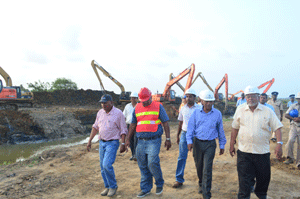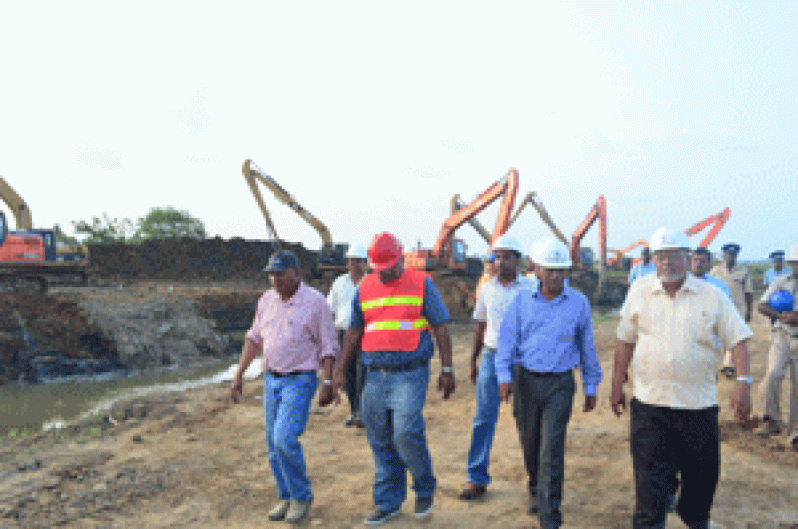–witness admits to telling different versions of same story
POLICE Ballistics Expert Sgt. Eon Jackson yesterday told the jury in the Cyon Collier, called “Picture Boy”, double-murder trial that the two casings and two fired bullets and pieces of lead he examined are all components of ammunition.
 Jackson told Madam Justice Diana Insanally and the mixed jury at the Demerara Assizes that when he examined an AK-47 assault rifle serially numbered 11081, along with an AK-47 rifle magazine, he had discharged three rounds from the weapon and found it to be a lethal barrel weapon in working order.
Jackson told Madam Justice Diana Insanally and the mixed jury at the Demerara Assizes that when he examined an AK-47 assault rifle serially numbered 11081, along with an AK-47 rifle magazine, he had discharged three rounds from the weapon and found it to be a lethal barrel weapon in working order.
Led by Senior State Counsel, Mrs. Judith Gildharie-Mursalin, the prosecution is contending that the accused used an AK-47 rifle to kill Ray Walcott, called ‘Sugar’, and his younger brother — Carl Andrews, called ‘Alo’, on the morning of September 23rd, 2006 at Victoria, East Coast Demerara.
Collier, known as ‘Picture Boy’, has pleaded not guilty to the charge, and is being represented by Attorney-at-Law, Lyndon Amsterdam.
The expert Jackson, who had been given a number of exhibits to analyse, said: “I then compared three fired casings against the two fired casings in a white envelope, and found that all five casings had the same firing pin impression and striation marks in identical sequence.
“I therefore form the opinion that the two casings which were in a white envelope marked ‘NB 11CJ’ were both discharged from the AK-47 assault rifle with serial No.11081, which is in brown paper parcel marked ‘MK 24 cj’.”
Witness said that after his examination, he placed his initials, ‘EJ’, on the shotgun and live cartridges, along with the two that he had discharged, resealed them in their respective parcels with police seal No. 95, and issued a ballistics analyst certificate of his findings to Detective Superintendent of Police Lord.
Quasi Stewart, another witness who testified at the resumption of the trial yesterday, recalled that on September 23, 2006, between 02:00 and 02:30 hrs, he and others were playing a game of dominoes at Victoria Road Front when “Picture Boy” rode up on a motor bike with a gun on his back.
Witness said the accused sent ‘Sugar’ to purchase cigarettes. After receiving the cigarettes, Cyon went into his grandmother’s yard nearby. When he returned from the yard, he came out cranking his gun, aimed at ‘Sugar’ and shot him.
Everybody started to run. He ran in a northerly direction. ‘Alo’ was running in the same direction. He saw ‘Alo’ jump over Nicole’s fence, resulting in Cyon calling on him to come out.
“Alo did not come out. I suspect that he might have been shot. I did not see Sugar again that night,” the witness testified. Witness, continuing, said he saw the accused join a bus with his gun.
In answer to further questions from the prosecutor, the witness, who because of ill health was allowed to sit in the well of the court to give evidence, said: “I never had any problem with “Picture Boy”… Picture Boy and Alo were friends… I did not see anyone else other than Cyon shooting that night… I gave a statement to the police.”
Under cross-examination by defence counsel, Mr. Amsterdam, the witness Quasi Stewart admitted that he had given different stories in two courts in relation to the same incident.
Witness admitted that he never told the magistrate at the preliminary inquiry that he had seen Picture Boy aim at ‘Sugar’ and shoot him.
He also admitted that he did not tell the magistrate that he had seen Alo jump over a fence, and that the accused had called him.
Witness also admitted that he did not tell the magistrate that he had seen the accused join a bus.
“I told the magistrate it was a dark night, but I told this court that there were lights,” he admitted.
Witness agreed that he had told the magistrate the truth, but refused to admit that what he told the High Court was a lie. He, however, agreed that both stories could not be true.




.jpg)









